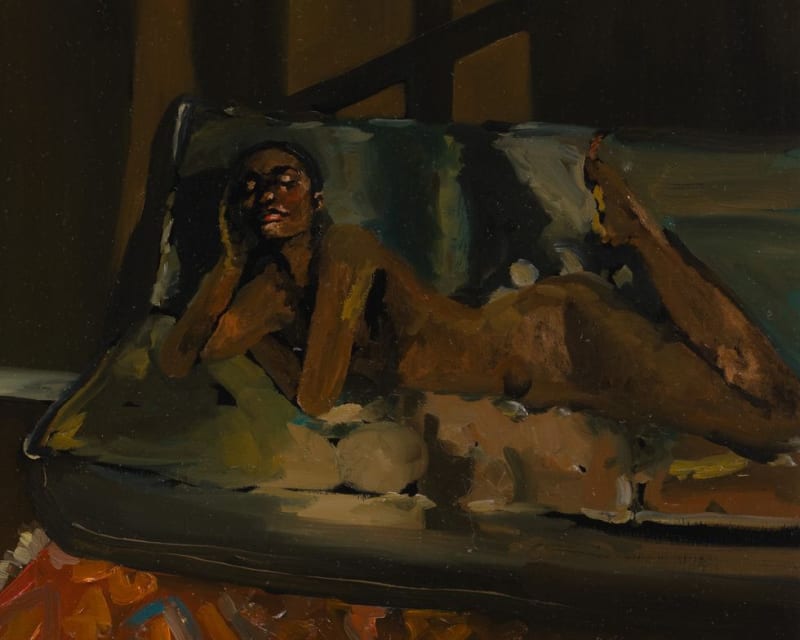BY SHELTON BOYD-GRIFFITH
Danielle Mckinney wants us all to slow down.
“I want the viewer to be still … and take it easy,” she tells Harper’s Bazaar, discussing her latest exhibition, “Quiet Storm.” The solo show, which opened earlier this month at Marianne Boesky’s white-box gallery in Chelsea, consists of 12 new paintings by the multidisciplinary artist, snapshots of Black women at ease in intimate interior spaces.
The exhibition’s title is inspired by Mckinney’s own personal journeys (or “internal storms,” as she puts it), as well as the radio format of the same name she listened to as a child, named after soul and R&B singer Smokey Robinson’s 1975 album A Quiet Storm.
“When I was young, my mom listened to 104.7, and [the radio DJ] was so soothing in the house,” she recalls. “I remember right before we went to bed, he would always say, ‘Quiet Storm, this is 104.7,’ and then he would play ‘You Bring Me Joy’ [by Anita Baker].” But with the Black femme figures Mckinney has rendered in oils, the exhibit is an intimate look into not just the artist’s own experiences, but also the collective internal journey of Black women as a whole.
And who exactly are those figures? Are they imagined subjects in the vein of Kerry James Marshall’s work, or interpretations of Mckinney and the other real Black women in her life? Well, neither, she says: “They’re really not anybody, because they’ve been deconstructed and collaged so much that they become a totally different figure.”
Originally trained as a photographer, the Jersey City–based artist used a process she created, which blends collaging and painting while still approaching the piece through a photographic perspective. “I am thinking about how I compose the model, how I compose the paint; I use a black background, like square format, or a photograph,” Mckinney says. “So, it’s all in visual seeing—everything’s always connected.” That is evident in the work on display. The paintings feel almost like stylized fashion editorials or personal Polaroids.
“Danielle’s paintings make me feel seen; the stillness, the ease, the reflection, and the contemplation characterized by her subjects resonate with me deeply,” says Amanda Murray, a fashion tastemaker and avid fan of Mckinney’s work. Other Black women feel the same—which is arguably what Mckinney wants to accomplish with her art. It centers on Black femmes in curated interior spaces—safe spaces—in moments of solitude, luxury, and rest, and the paintings on view in “Quiet Storm” evoke the theme vividly.
Mckinney’s women are imagined figures in rich, hyperrealistic interiors, wrapped up in luxurious blankets, lounging on Togo sofas, draped in silk robes—all echoing back to that sense of stillness. Several figures display an intimate form of freedom and relaxation, painted in the nude, often while smoking. Of the cigarette as a motif, the artist says, “It’s not really about the cigarette—it’s about that moment of exhale. So I paint that in a narrative way, of that exhale moment.” There is intention in every facet of Mckinney’s paintings, all offering a sense of respite to the viewer.
Interdisciplinary artist Shefon Taylor says seeing the show brought questions “beyond the idea of rest and solitude” to the surface for her.
“In shadows and spotlighted in darkness, the women seem to be a stage of themselves, somehow,” she tells Bazaar. “Figures caught at the inhale, engaged in some ongoing attempt to resolve or untangle themselves, an effort that I walked away [from] wondering if that would ever be a possibility—for both them and myself.”
While a time of uncertainty, the COVID-19 pandemic also allowed artists like Mckinney to look within themselves. And like many others, she was looking for a way to connect. What started as a creative outlet during lockdown turned into the exploration of a new medium and a whole new audience—all at home, and thus primed to relate to the figures in the paintings—courtesy of Instagram. Murray was one of those spectators, and felt a sense of freedom seeing Mckinney’s work online then. “The pandemic was tough for me, but ultimately, it left a somewhat positive impact on me,” she says. “I no longer feel like every day has to be rushed. It forced me to slow down, and I see that in her work—they are Black women free from the constraints of the world and free within themselves.”
There is a sense of liberation in Mckinney’s paintings, seeing Black femmes in their safe spaces. Besides sharing the thematic through line of calm and rest, the figures in “Quiet Storm” are all also incredibly stylish, which reads as intentional. They serve as a study of the “Black women and luxury” discourse. Take Evening Star, from the exhibit, for example: It depicts a woman resting on a textured rug, enjoying that moment of exhale. She is styled with red nails, a middle part, slicked-back hair, and a lush chartreuse kimono. “I like to adorn them,” Mckinney says of her figures.
While her subjects tend to be effectively fictional, she says her mother has been and continues to be a source of inspiration for them. “A lot of [the aesthetic and glam of the paintings] I think is just subconsciously from my mom,” Mckinney says. “She had Avon products, and this lotion that I remember smelt so good. I grew up with women that really didn’t have anything, but what we had, we just really made the best of it. And we always made ourselves look great.”
“Quiet Storm” is on view until April 27 at Marianne Boesky Gallery, 509 West 24th Street, in New York City, Tuesday through Saturday between 10:00 a.m. and 6:00 p.m.


